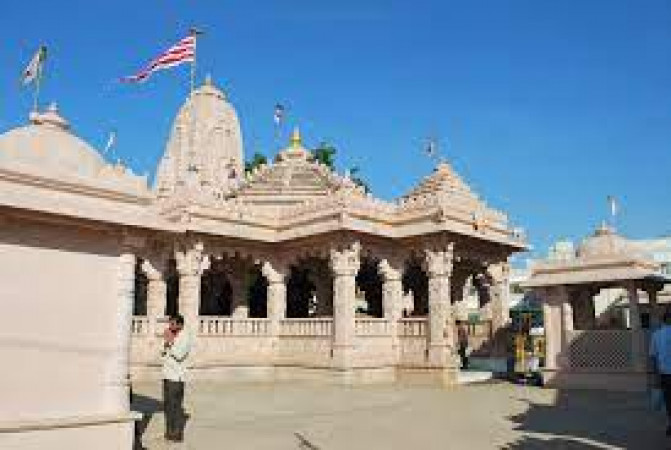Mata No Madh Travel Guide
Mata No Madh is a small village located in the Kutch district of Gujarat, India. Known for its religious significance, it is a popular pilgrimage site for devotees of Maa Ashapura. The village is nestled amidst the picturesque landscape of the Rann of Kutch and offers a serene retreat for spiritual seekers and nature lovers alike.Top Attractions in Mata No Madh
- Visit the revered Maa Ashapura Temple
- Explore the vast expanses of the White Rann
- Experience the vibrant culture at the Rann Utsav
Mata No Madh is Famous for
The village of Mata No Madh is most famous for being the abode of Maa Ashapura, the reigning deity of the region.Top Attractions in Mata No Madh
- Seek blessings at Maa Ashapura Temple
- Witness the mesmerizing sunset at White Rann
- Indulge in local handicraft shopping at the Rann Utsav
What's Great about Travelling to Mata No Madh?
- Perfect destination for spiritual seekers
- Unique cultural experiences
- Scenic beauty of the Rann of Kutch
What's Not So Great about Travelling to Mata No Madh?
- Limited accommodation options
- Extreme weather conditions in summer
- Remote location with limited amenities
Travel Tips for Mata No Madh
- Carry sufficient water and sunscreen
- Respect local customs and traditions
- Plan your visit during the Rann Utsav for a vibrant experience
Important Mata No Madh trip information
- Ideal Duration: A weekend trip is ideal to explore the main attractions.
- Best Time to Visit: Visit during the winter months from October to February for pleasant weather.
- Nearby Airports and Railway Stations: The nearest airport is Bhuj Airport, and the closest railway station is Bhuj Railway Station.
FAQ's on Mata No Madh
Q1: What is the best time to visit Mata No Madh?
The best time to visit Mata No Madh is during the winter months from November to February when the weather is pleasant and ideal for exploring the outdoors. Avoid the summer months as temperatures can soar, making it uncomfortable for sightseeing. The annual Rann Utsav held from November to February is a popular event showcasing the local culture and crafts.
Q2: Do I need a visa to travel to Mata No Madh?
Travelers to Mata No Madh typically require a tourist visa. Check with the nearest embassy or consulate for specific visa requirements based on your nationality. Some nationalities may be eligible for visa-on-arrival or e-visa facilities. Make sure your passport has a minimum validity of six months from the date of entry.
Q3: What are the must-visit attractions in Mata No Madh?
Mata No Madh offers a unique experience with attractions like the White Rann, Kalo Dungar (Black Hill), Mandvi Beach, and the Vijay Vilas Palace. Don't miss the handicraft markets for traditional textiles and artifacts. Wildlife enthusiasts can explore the nearby Narayan Sarovar Sanctuary for its diverse flora and fauna.
Q4: Is Mata No Madh a safe place to travel?
Mata No Madh is generally considered safe for tourists. However, exercise caution in crowded areas and be mindful of your belongings. It is advisable to respect local customs and dress modestly, especially in religious sites. Avoid isolated areas at night and use authorized transportation services.
Q5: What is the local currency in Mata No Madh and can I use credit cards?
The local currency in Mata No Madh is the Indian Rupee (INR). Credit cards are accepted in major hotels, restaurants, and shops in tourist areas. It is advisable to carry cash for smaller establishments and markets. ATMs are available in towns like Bhuj for easy access to cash.
Q6: What is the local cuisine like in Mata No Madh?
Mata No Madh offers a diverse culinary experience with traditional Gujarati cuisine like dhokla, thepla, and fafda being popular choices. Seafood lovers can indulge in fresh catches along the coast. Don't miss trying the local specialties like Kutchi Dabeli and Gujarati thali for a flavorful meal.
Q7: What transportation options are available in Mata No Madh?
Transportation options in Mata No Madh include buses, taxis, and auto-rickshaws for local travel. Renting a car or hiring a driver is recommended for exploring the region at your own pace. Shared jeeps are also available for traveling to remote areas like the Rann of Kutch.
Q8: Are there any cultural norms or etiquette I should be aware of when visiting Mata No Madh?
When visiting Mata No Madh, it is important to respect local customs and traditions. Dress modestly, especially when visiting religious sites or rural areas. Remove shoes before entering temples and homes. Greet people with a polite "Namaste" and seek permission before taking photographs, especially of locals. Embrace the warm hospitality of the locals and enjoy the rich cultural heritage of the region.
Q9: I am a travel agent. How can I buy travel leads of Mata No Madh?
Register yourself as a travel agent at agents.tripclap.com and then you can buy travel leads to Mata No Madh once your account is approved. For more details contact our support team at +91-8069186564 or support@tripclap.com

